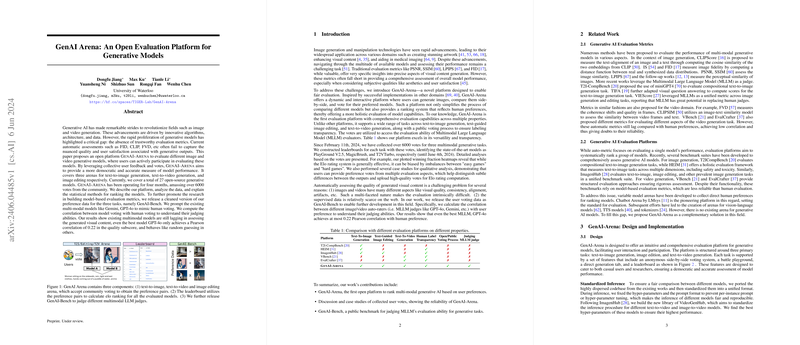GenAI Arena: An Open Evaluation Platform for Generative Models
The paper "GenAI Arena: An Open Evaluation Platform for Generative Models" addresses a pressing challenge in the domain of generative AI— the reliable and comprehensive evaluation of generative models. Generative models have seen rapid advancements, particularly in text-to-image, image editing, and text-to-video generation tasks. However, assessing their performance remains problematic due to the inadequacies of existing automatic metrics and the subjectivity of human judgments.
Key Contributions
The authors introduce GenAI-Arena, a novel evaluation platform that democratizes the evaluation process by leveraging community votes. The platform allows users to participate directly in comparing the outputs of various generative AI models. It collects preferences and votes to provide a more accurate measure of model performance. Three specific tasks are highlighted within the platform:
- Text-to-Image Generation
- Image Editing
- Text-to-Video Generation
The GenAI-Arena is backed by the largest array of open-source models yet evaluated together, covering 27 distinct generative models. The platform has collected over 6000 votes in its operational span of four months, bolstering its rankings and evaluations.
Methodology
The methodology relies on a dynamic and interactive interface where users can anonymously vote on side-by-side comparisons of generative model outputs. The votes are evaluated using the Elo rating system, modified to account for the inherently subjective nature of human preferences in visual content. The system updates model rankings based on votes to determine relative performance accurately.
The paper also describes the release of GenAI-Bench, a cleaned dataset derived from user voting data. This data is aimed at promoting research into model-based evaluation metrics. By prompting multimodal models like GPT-4o to mimic human voting, the authors compute correlations between model voting and human preferences. Notably, GPT-4o achieves a Pearson correlation of 0.22 in assessing visual content quality, suggesting that current multimodal models still lag far behind human judgment.
Results and Analysis
The leaderboard rankings yielded several insights:
- Text-to-Image Generation: The models PlayGround V2.5 and Playground V2 led in performance, significantly outperforming the baseline SDXL model.
- Image Editing: MagicBrush ranked highest, highlighting the efficacy of trained models over zero-shot approaches like Pix2PixZero and SDEdit.
- Text-to-Video Generation: T2V-Turbo emerged as the top performer, with the leaderboard introducing methods that balanced computational efficiency with output quality.
The winning fraction heatmaps and case studies confirmed that user preferences effectively highlighted subtle differences between model outputs, reinforcing the robustness of the platform's evaluation methodology. The analysis also raised the point that Elo ratings could be slightly biased due to the imbalance between "easy" and "hard" competitions.
Implications and Future Work
The implications of this work are dual-faceted. Practically, GenAI-Arena simplifies the evaluation of multiple generative models, providing a reliable reference for both developers and users of generative AI. Theoretically, it offers a robust dataset—GenAI-Bench—for the research community, encouraging the development of better model-based evaluation metrics. The findings also underscore the limitations of current multimodal models in evaluating visual content, pointing toward the need for more advanced evaluative AI systems.
In future developments, continuous data collection will enhance the leaderboard's accuracy, making it reflective of the latest generative AI advancements. Additionally, there is scope for developing more sophisticated MLLMs to better mirror human judgments.
Conclusion
The paper underscores the necessity for effective evaluation strategies in generative AI. By introducing GenAI-Arena, it addresses a critical gap, providing a platform that integrates user feedback into model evaluations and establishes clear performance benchmarks. The results highlight both the capabilities and limitations of current evaluation metrics and models, offering pathways for future advancements.
